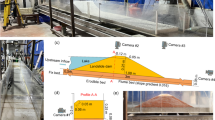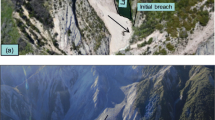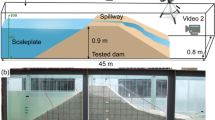Abstract
The geometries and material properties of a landslide dam depend on the dam formation process and affect the breaching process. A comprehensive understanding of the entire process of dam formation and breach is necessary for a more accurate analysis of the dam stability and failure characteristics, but little research has been done in this area. In this study, the effects of debris composition, sliding width, and valley shape on dam breaching by considering dam formation features were experimentally investigated. Results reveal that the stability and failure modes of landslide dams are predominantly governed by the debris composition. The dam stability increases with mean grain size, especially the grain size at the overflow location. Dam height and width are largely influenced by debris composition and sliding width, and the lake volume is highly dependent on the valley shape. The arrival time of peak discharge for balance-grained dams is more related to the dam height than the lake volume, while fine-grained dams are the opposite. The peak discharge is significantly influenced by the lake volume and released water volume, while the effects of dam height, downstream slope, and lake shape coefficient are negligible. Balance-grained dams exhibit two longitudinal evolution models in different shaped valleys. The evolution model of fine-grained dams is different from that of balance-grained dams and is independent of valley shape. This study improves our current understanding of the whole process of landslide dams from formation to failure and the effects of dam formation features on dam breaching.




















Similar content being viewed by others
References
Casagli N, Ermini L, Rosati G (2003) Determining grain size distribution of the material composing landslide dams in the Northern Apennines: sampling and processing methods. Eng Geol 69(1–2):83–97
Chang DS, Zhang LM (2010) Simulation of the erosion process of landslide dams due to overtopping considering variations in soil erodibility along depth. Nat Hazards Earth Syst Sci 10(4):933–946
Chang DS, Zhang LM, Xu Y, Huang RQ (2011) Field testing of erodibility of two landslide dams triggered by the 12 May Wenchuan earthquake. Landslides 8:321–332
Chen SC, Lin TW, Chen CY (2015) Modeling of natural dam failure modes and downstream riverbed morphological changes with different dam materials in a flume test. Eng Geol 188:148–158
Chinnarasri C, Tingsanchali T, Weesakul S, Wongwises S (2003) Flow patterns and damage of dike overtopping. Int J Sedim Res 18(4):301–309
Costa JE (1985) Floods from dam failures. US Geol Surv Open-File Rep 85–560:54
Costa JE, Schuster RL (1988) The formation and failure of natural dams. Geol Soc Am Bull 100(7):1054–1068
Cui P, Zhu YY, Han YS, Chen XQ, Zhuang JQ (2009) The 12 May Wenchuan earthquake-induced landslide lakes: distribution and preliminary risk evaluation. Landslides 6(3):209–223
Dai LX, Fan XM, Jansen JD, Xu Q (2021) Landslides and fluvial response to landsliding induced by the 1933 Diexi earthquake, Minjiang River, eastern Tibetan Plateau. Landslides 18(9):3011–3025
Delaney KB, Evans SG (2015) The 2000 Yigong landslide (Tibetan Plateau), rockslide-dammed lake and outburst flood: review, remote sensing analysis, and process modelling. Geomorphology 246:377–393
Dunning SA, Armitage PJ (2011) The grain-size distribution of rock-avalanche deposits: implications for natural dam stability. Natural and artificial rockslide dams. Springer, Berlin, Heidelberg, pp 479–498
Fan XY, Qiao JP (2010) Influence of landslide and ground factors on large-scale landslide movement. Chin J Rock Mech Eng 29(11):2337 (In Chinese)
Fan XM, Scaringi G, Korup O et al (2019) Earthquake-induced chains of geologic hazards: patterns, mechanisms, and impacts. Rev Geophys 57(2):421–503
Fan XM, Dufresne A, Subramanian SS et al (2020) The formation and impact of landslide dams–state of the art. Earth Sci Rev 203:103116
Iverson RM, Logan M, LaHusen RG, Berti M (2010) The perfect debris flow? Aggregated results from 28 large‐scale experiments. J Geophys Res Earth Surface 115(F3)
Iverson RM (2015) Scaling and design of landslide and debris-flow experiments. Geomorphology 244:9–20
Jiang XG, Huang JH, Wei YW, Niu ZP, Chen FH, Zou ZY, Zhu ZY (2018) The influence of materials on the breaching process of natural dams. Landslides 15(2):243–255
Jiang XG, Wei YW (2020) Erosion characteristics of outburst floods on channel beds under the conditions of different natural dam downstream slope angles. Landslides 17(8):1823–1834
Kuo YS, Tsang YC, Chen KT, Shieh CL (2011) Analysis of landslide dam geometries. J Mt Sci 8(4):544–550
Liu W, He SM (2018) Dynamic simulation of a mountain disaster chain: landslides, barrier lakes, and outburst floods. Nat Hazards 90(2):757–775
Mei SY, Chen SS, Zhong QM, Shan YB (2021) Effects of grain size distribution on landslide dam breaching—insights from recent cases in China. Front Earth Sci 9:245
Peng M, Zhang LM (2012) Breaching parameters of landslide dams. Landslides 9(1):13–31
Powledge GR, Ralston DC, Miller P, Chen YH, Clopper PE, Temple DM (1989) Mechanics of overflow erosion on embankments. II: Hydraulic and design considerations. J Hydra Eng 115(8): 1056–1075
Roessler T, Richter C, Katterfeld A, Will F (2019) Development of a standard calibration procedure for the DEM parameters of cohesionless bulk materials–part I: Solving the problem of ambiguous parameter combinations. Powder Technol 343:803–812
Ruan HC, Chen HY, Li Y, Chen JG, Li HB (2021) Study on the downcutting rate of a debris flow dam based on grain-size distribution. Geomorphology 391:107891
Schmocker L, Hager WH (2009) Modelling dike breaching due to overtopping. J Hydraul Res 47(5):585–597
Schilirò L, Esposito C, De Blasio FV, Scarascia Mugnozza G (2019) Sediment texture in rock avalanche deposits: insights from field and experimental observations. Landslides 16(9):1629–1643
Shang YJ, Yang ZF, Li LH, Liu DA, Liao QL, Wang YC (2003) A super-large landslide in Tibet in 2000: background, occurrence, disaster, and origin. Geomorphology 54(3–4):225–243
Shen DY, Shi ZM, Peng M, Zhang LM, Jiang MZ (2020) Longevity analysis of landslide dams. Landslides 17(8):1797–1821
Visser PJ (1998) Breach growth in sand-dikes. Dissertation, Delft University of Technology
Walder JS, O’Connor JE (1997) Methods for predicting peak discharge of floods caused by failure of natural and constructed earthen dams. Water Resour Res 33(10):2337–2348
Xu Q, Fan XM, Huang RQ, Westen CV (2009) Landslide dams triggered by the Wenchuan Earthquake, Sichuan Province, south west China. Bull Eng Geol Env 68(3):373–386
Yang Y, Cao SY, Yang KJ, Li WP (2015) Experimental study of breach process of landslide dams by overtopping and its initiation mechanisms. J Hydrodyn 27(6):872–883
Yin Y, Wang F, Sun P (2009) Landslide hazards triggered by the 2008 Wenchuan earthquake, Sichuan. China Landslides 6(2):139–152
Zhang JY, Fan G, Li HB, Zhou JW, Yang XG (2021) Large-scale field model tests of landslide dam breaching. Eng Geol 293:106322
Zhang RJ, Xie JH, Chen WB (2007) River dynamics. Wuhan University Press: Wuhan, China, pp 46–60 (In Chinese)
Zhao GW, Jiang YJ, Qiao JP, Yang ZJ, Ding PP (2019) Numerical and experimental study on the formation mode of a landslide dam and its influence on dam breaching. Bull Eng Geol Env 78(4):2519–2533
Zheng HC, Shi ZM, Shen DY, Peng M, Hanley KJ, Ma CY, Zhang LM (2021) Recent advances in stability and failure mechanisms of landslide dams. Front Earth Sci 9:201
Zheng HC, Shi ZM, Peng M, Guan SG, Hanley KJ, Feng SJ (2022) Amplification effect of cascading breach discharge of landslide dams. Landslides, 1–15
Zhong QM, Chen SS, Mei SA, Cao W (2018) Numerical simulation of landslide dam breaching due to overtopping. Landslides 15(6):1183–1192
Zhong QM, Chen SS, Deng Z, Mei SA (2019) Prediction of overtopping-induced breach process of cohesive dams. J Geotech Geoenviron Eng 145(5):04019012
Zhou GGD, Zhou MJ, Shrestha MS et al (2019a) Experimental investigation on the longitudinal evolution of landslide dam breaching and outburst floods. Geomorphology 334:29–43
Zhou YY, Shi ZM, Zhang QZ, Jang B, Wu CZ (2019b) Damming process and characteristics of landslide-debris avalanches. Soil Dyn Earthq Eng 121:252–261
Zhou YY, Shi ZM, Zhang QZ, Liu WR, Peng M, Wu CZ (2019c) 3D DEM investigation on the morphology and structure of landslide dams formed by dry granular flows. Eng Geol 258:105151
Zhou YY, Shi ZM, Qiu T, Yu SB, Zhang QZ, Shen DY (2021) Experimental study on morphological characteristics of landslide dams in different shaped valleys. Geomorphology 108081
Zhu XH, Peng JB, Liu BX, Jiang C, Guo J (2020) Influence of textural properties on the failure mode and process of landslide dams. Eng Geol 271:105613
Zhu XH, Liu BX, Peng JB et al (2021) Experimental study on the longitudinal evolution of the overtopping breaching of noncohesive landslide dams. Eng Geol 288:106137
Acknowledgements
The research in this paper was supported by the National Natural Science Foundation of China (No. 41731283). The third author is a collaborator and supported by the US National Science Foundation under award No. CMMI-1453103. These supports are gratefully acknowledged.
Author information
Authors and Affiliations
Corresponding author
Ethics declarations
Conflict of interest
The authors declare no competing interests.
Rights and permissions
About this article
Cite this article
Zhou, Y., Shi, Z., Qiu, T. et al. Failure characteristics of landslide dams considering dam formation features in laboratory experiments. Landslides 19, 2379–2395 (2022). https://doi.org/10.1007/s10346-022-01907-6
Received:
Accepted:
Published:
Issue Date:
DOI: https://doi.org/10.1007/s10346-022-01907-6




